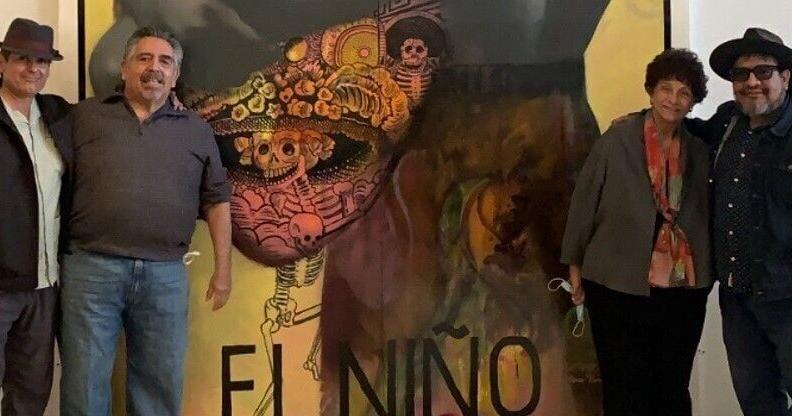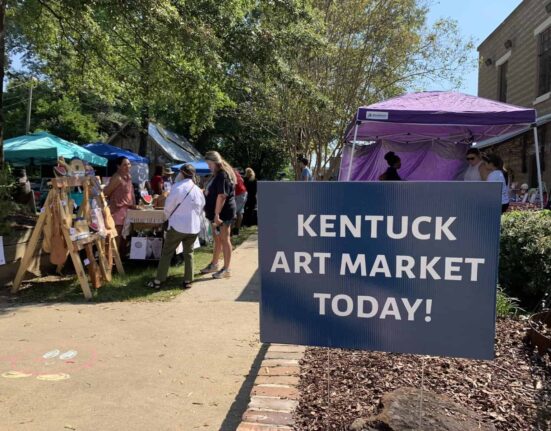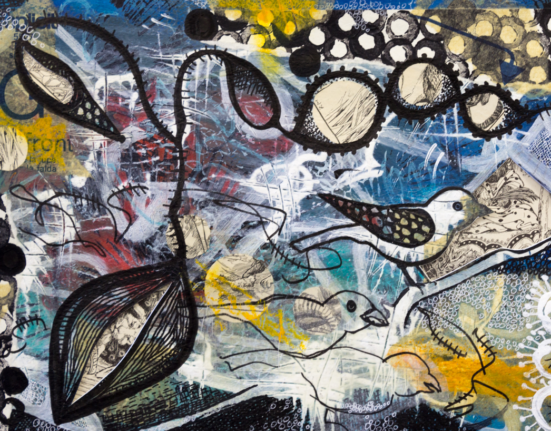Ruben Sanchez’s passion for art and farmworkers is as deeply rooted as the fields where he almost came into the world.
The vibrant colors of California’s Central Valley fields serve as the palette Sanchez uses to bring to life, through his paintings, the memories of his family and the ancestors of all who have toiled there.
As a campesino artist (a term describing farmworker-related art), Sanchez captures the essence of a life lived close to the land and its labor.
Whether creating an earth-toned mural that echoes the skin tones of those who labor under the sun to cultivate our food or capturing the cherry-red tomatoes he picked alongside his family, Sanchez’s deep connection to the people and culture of the Valley is undeniable.
These formative experiences in the fields and his family’s legacy of labor have profoundly shaped Sanchez’s artistic vision, leading him to create large murals, oil paintings and screenprints that honor the strength and spirit of farmworkers like those who shaped his own life.
“It’s a reflection (of my surroundings),” he said. “It just seemed natural because that’s a part of me. That’s a part of being Latino. My story is just one of hundreds. I started doing this because when I looked at art, I didn’t see myself.”
Roots in the Valley
The 71-year-old’s origin story began under the sun in Firebaugh in the 1950s, where his mother, while picking cotton, was rushed to a nearby hospital to deliver him by cesarean section.
From his early days, he was a regular in the fields his family worked in, where he learned about hard work and artistic pursuits. Much of that time was in the Merced County community of Planada, where his family picked tomatoes.
“When I was 5 years old, my parents took me to the field ‘para ver qué hace el niño’ – to see what the kid would do,” Sanchez recalled in Spanish. “My dad made me a can out of coffee cans with a wire, and I would fill it with tomatoes and dump it.”
In the early 1960s, 8-year-old Sanchez experienced a profound revelation during a trip with his father to Palo Alto, Jalisco, Mexico. It was his first encounter with the world his father had grown up in — a place vastly different from what he was accustomed to.
“I began to see a part of me that I didn’t know existed,” Sanchez said. “It was like time traveling at the rancho. There was no water, no electricity, no nothing.”
The contrast between the nearby developed city of Guadalajara, his home in the Central Valley, and Jalisco’s rural areas shocked a young Sanchez. Life there was entirely different, a stark reminder of a past he hadn’t known.
“It was like going back 100 years,” he reflected. “Now it’s different, but at that time, it was like that.”
By age 9, back at home, he was helping pack tomatoes into boxes, earning a small pay that fueled his love for comic books and kickstarted his career in the fields. “At 12, I started getting a man’s wage,” said Sanchez. “I would put in a man’s time and I would get paid as an adult.”
Discovering his path at an early age
Although Sanchez always showed an interest in art through the comic books he read and the murals he saw growing up, he realized his talent in middle school when one of his pieces became the talk of the seventh grade.
“It was for Father’s Day and other kids would ask me to paint their dads, too,” Sanchez said. “Then, when I was 12, my mom got me a paint-by-numbers and instead of painting what was there, I painted Jesus Christ with oil. That got me going in art.”
As Sanchez continued working in the fields, he also pursued his education, eventually earning an associate’s degree in general education from Merced College. His dream was to shape young minds through art.
“I’ve wanted to become an art teacher since high school,” Sanchez recalled. “But my parents insisted I study business. My heart wasn’t in it, so nothing came of it. I just continued to do art on the side.”
Merging art with the campesino legacy
Sanchez found the business classes boring, which caused him to get bad grades. However, during an art class, he was introduced to three artists who would inspire his art moving forward.
The “Big Three,” as he calls them — David Alfaro Siqueiros, Jose Clemente Orozco, and Diego Rivera — blew him away as Sanchez read everything he could get his hands on about them and meticulously studied their art.
These maestros of Mexican muralism captured the working class’s struggles, aspirations, and indomitable spirit through bold, sweeping visuals.
Sanchez found himself drawn to their use of vibrant colors, powerful imagery and the unapologetic celebration of the everyday laborer embodied into walls and canvases.
This influence birthed Sanchez’s interpretation of campesino art, where his brush became a tool for honoring the legacy of farmworkers, much like Rivera’s depictions of Indigenous life, Orozco’s portrayal of the Mexican Revolution, and Siqueiros’ dynamic, explosive compositions.
Sanchez’s works of art, whether on a canvas with oils, a screenprint, or a mural that covers the perimeter of a local school, are homages to the sun-soaked fields of the Central Valley.
His art captures not just the physicality of labor but also the deep-rooted connection to the land, the culture, and the history that defines the farm working experience where the colors of the earth meld with the sweat of those who work it.
With each stroke, he hopes to pay tribute to the resilience and dignity of those who, like his own family, have toiled under the Valley’s sun.
Finding new opportunities for expression
In 1979, Sanchez found a chance to expand his artistic skills through a program with the Central Valley Opportunity Center.
This program taught campesinos new skills, including promotional window painting for local businesses during Christmas.
“At the time, it was difficult to learn new trades, especially if you’re always in the fields,” he said. “They were trying to teach people how to get away from that. So they taught me how to window paint.”
For many years, Sanchez decorated the windows of Merced’s businesses to supplement his income until he retired in 2023, as the physically demanding work became too challenging with age.
When Sanchez married his wife Linda in 1976, he decided to join his father, a contractor who ran crews of farmworkers to work the fields.
“Cuando te casas, tienes que mantenerte – Once you’re married, you have to support your family,” he said in Spanish.
Later, Sanchez and his wife, Linda, became entrepreneurs, selling produce at various swap meets across the region.
For 25 years, they thrived in this work, making a name for themselves in the remates (swap meets). But their life took a tragic turn in 2011 when Linda was killed in a car accident.
“That changed things,” said Sanchez. “I still worked the flea market, but it wasn’t with the same enthusiasm.”
Fulfilling a dream in his father’s homeland
Ever since his first visit to Mexico, Sanchez harbored a dream of showcasing his art in the country whose culture shaped him, even though he grew up on the U.S. side of the border.
He saw how the region transformed over the years as farmworkers returning from laboring in foreign fields brought back the amenities they experienced across the river.
In 2008, while visiting his father’s homeland, Sanchez was determined to showcase his art. However, he faced rejection from galleries unwilling to feature an American artist’s work.
“I would go to Guadalajara where the Orozco Mural was and I always wanted to have a show there,” he said. “They told me they only wanted to show (Mexican) nationals people’s work.”
Ever persistent, Sanchez kept trying despite being thrown out three times until a lady whose raspy voice he remembers told him of a gallery that would display his art in Tlaquepaque—a vibrant area near Guadalajara celebrated for its traditional arts, crafts, and historic architecture.
Sanchez was well received in Tlaquepaque. He met a radio host who invited him to one of his shows.
“One aspect about art that we never talk about, and we don’t realize how important it is, is being at the right place at the right time, being lucky, being asked that opportunity, and taking advantage of it,” he said.
That encounter led to Sanchez having a solo show the following winter and the opportunity to create a mural for a hotel a summer later.
“It was a very nice hotel,” he said. “They gave me a room at the base of the mural. My wife, my daughter, and I lived there for seven weeks. Doing a mural in Mexico was my dream come true. Working in Guadalajara on a mural just blew my mind. That was the fulfillment of my dream.”
Infusing Mexican traditions: Sanchez’s Celebration of Dia de los Muertos
Before the film, “Coco” brought Dia de los Muertos to mainstream attention, many in the U.S. had little understanding of this rich Mexican tradition.
Dia de los Muertos, or the Day of the Dead, is a vibrant celebration where families honor their deceased with elaborate altars adorned with photos, mementos, and offerings.
Traditionally observed annually on Nov. 2, the holiday is deeply rooted in Mexican culture, blending ancient indigenous practices with Catholic influences.
In 1999, while recuperating from surgery in Mexico, Ruben Sanchez encountered news reports showcasing the altars that decorated Mexican cemeteries for Dia de los Muertos. The sight was a revelation.
“I was surprised,” Sanchez said. “Every morning show, every news show was showing their altars. I found that really fascinating. Everybody had an altar.”
Upon returning to Merced, Sanchez was determined to bring this tradition to his community.
In 2000, he initiated the Dia de los Muertos celebration at the Merced Multicultural Arts Center.
“We got a half room upstairs and I would invite three or four artists,” Sanchez said. “Each artist would do it their way. We did it for about 16 years.”
The celebration grew steadily, transforming the MAC into a vibrant hub for honoring the dead.
“He started off small and every year, it got bigger and bigger,” said MAC Executive Director Colton Dennis. “At its height, we had over 800 people attend the DDLM reception and candlelight procession. Throughout the years, Ruben was on the committee that organized and curated the exhibition.”
Sanchez also created a unique altar in honor of his wife, which was showcased at the 2013 Arte Americas in Fresno.
“I did 16 drawings of the life of my wife,” he said. “I did a summary of each drawing reflecting her journey. I’ve always felt that the dead are still with us; I know my wife is still with me every day.”







